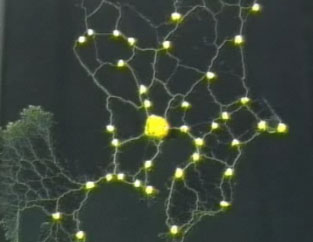 One of the interesting creatures that I learned about when I attended Christopher Lloyd’s lecture at the Royal Institution was the slime mould. He explained how individual pieces joined together to find the quickest, most efficient way through a maze to reach food that had been placed at the entrances. Over at the BBC I found another fascinating article about slime moulds. Scientists have come to the conclusion that the way that slime moulds grow could help engineers design wireless communication networks.
One of the interesting creatures that I learned about when I attended Christopher Lloyd’s lecture at the Royal Institution was the slime mould. He explained how individual pieces joined together to find the quickest, most efficient way through a maze to reach food that had been placed at the entrances. Over at the BBC I found another fascinating article about slime moulds. Scientists have come to the conclusion that the way that slime moulds grow could help engineers design wireless communication networks.
Scientists drew this conclusion after observing a slime mould as it grew into a network that was almost identical to the Tokyo rail system.
The scientists describe their ideas for “biologically inspired networks” in the journal Science.
They have incorporated the slime mould’s efficient strategy into a mathematical formula.
This “slime formula” could help engineers develop better, more efficient designs.
The single amoeboid cells of slime moulds fuse and spread into a network as they feed and grow.“These biological networks have been honed by many cycles of evolutionary selection pressure,” wrote the researchers in their article.
The research team, led by Dr Atsushi Tero from Hokkaido University, Japan, wanted to capture this evolved efficiency, which they say could be used to inform human engineering decisions.
The scientists put the slime to the test by allowing it to grow on a wet surface on which they placed oat flakes in locations that corresponded to the cities surrounding Tokyo.
They placed the slime mould, Physarum polycephalum, in the centre.
As it grew outwards, it organised itself into a network around the food that closely resembled the train network connecting Tokyo to its surrounding cities.
The researchers then converted this growth “strategy” into a mathematical formula.
The researchers say that this model could provide a starting point for improving the efficiency and even decreasing the cost of “self-organised networks”, such as computer and mobile communication networks that are not centrally controlled.
The idea for using slime moulds in this ways inspired by Toshiyuki Nakagaki, who was responsible for showing that the slime could find the most efficient way through a maze.








How did you know I’d just had dinner and was on the coffee, Cherie?
Probably because I had just had dinner and the tea was brewing
Nothing to worry. Polycephalum is just another name for the Hydra.
Aah the beautiful Hydra
If they’re not careful, one day, they’ll create Something that will replace us instantly.
Maybe the slime will manage that all on it’s own accord!!!
I found this very interesting, but not surprising. Nature solved many problems for itself before mankind ever existed.
Adapt, solve and survive.
I was looking at my ’sprout tree’ the other day and was fascinated by the spiral nature of its growth. There were five spirals which repeated over 15″. To us engineers this is known as:-
“Fifteen inch pitch, five start thread”.
But nature got the first.
Cheers……Bernard
Nature is amazing maybe man should take more notice from it rather than try and improve it.
Thanks for the info on engineering
Fascinating post, Cherie. Science does learn from what is already there – but apparently only by observing using the right technology, and applying the correct mathematical formulae!
Yes it could lead to a disaster if the wrong formulae was used!
Slime has also been proved to be not useful and is potentially very harmful as can be proven in link below.
http://andrewbenmckay.com/images/Cabinet.jpg
LOL Are you trying to lower the tone of my blog and destroy the reputation of the slime mould?
Interesting. I never heard of that before.
Nor me